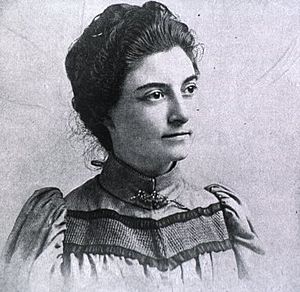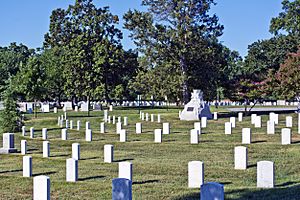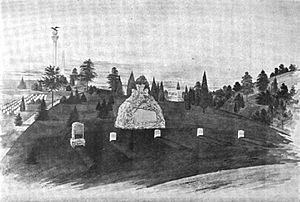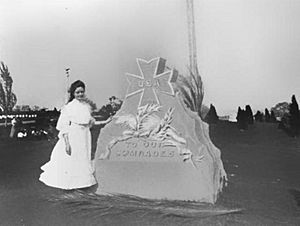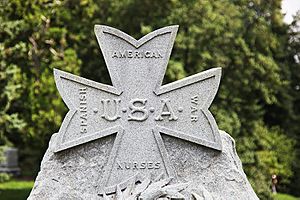Spanish–American War Nurses Memorial facts for kids
Quick facts for kids Spanish–American War Nurses Memorial |
|
|---|---|
| United States | |
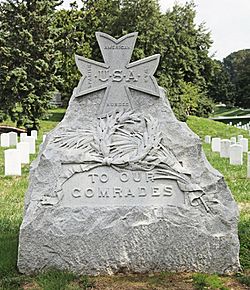
Spanish–American War Nurses Memorial in 2011
|
|
| For those American nurses who died in the Spanish–American War | |
| Unveiled | May 4, 1905 |
| Location | 38°52′30″N 77°04′31″W / 38.874862°N 77.075214°W near |
The Spanish–American War Nurses Memorial is a special monument located in Arlington National Cemetery in Arlington County, Virginia, USA. It honors American nurses who died during the Spanish–American War in 1898. This memorial is made of rough, grey granite. The Order of Spanish–American War Nurses built it on May 2, 1905. You can find it in the southwest part of Section 21, which is where the first nurses from that war are buried.
It's important not to confuse this memorial with the Nurses Memorial. That one is an 8-foot (2.4 m) tall marble statue of a nurse in uniform. It was put up in 1938, also in Section 21, but a bit further away.
Contents
Why Were Nurses Needed in the Spanish–American War?
The Spanish–American War was a short conflict in 1898, lasting about ten weeks. Cuba was fighting for its freedom from Spain, and the United States supported Cuba. The U.S. had strong business ties there. To protect American citizens and their property, the U.S. sent the battleship USS Maine (ACR-1) to Havana in January 1898.
On February 15, the Maine exploded, and many lives were lost. American newspapers quickly blamed Spain, which made people want war. The United States Congress then demanded Cuba's independence. President William McKinley signed this into law on April 20. Spain ended its diplomatic relations the next day. The United States Navy also started blocking Cuba by sea. Spain declared war on April 23, and the U.S. Congress declared war on April 25.
The war began on April 25, 1898, and ended on August 12, 1898. Many more Cuban and Spanish soldiers died than Americans. Out of 2,910 American military deaths, only 345 were from fighting. Most died from diseases. Before this war, the U.S. military did not allow women to serve. The Army had 791 male nurses, but this was not enough. Soldiers did not want to become nurses, and few people volunteered for medical duty.
Congress quickly allowed the military to hire female nurses. However, they were hired on contract, not as regular military members. The army asked the Daughters of the American Revolution (DAR), a patriotic group, to help find women nurses. Dr. Anita Newcomb McGee, a doctor in the U.S., led this effort. They recruited 1,563 nurses for the new Nurse Corps. Most worked in hospitals in the United States. Only a few were sent to places like Cuba, the Philippines, or Puerto Rico. Some also worked on the hospital ship USS Relief. This was the first time nurses were fully accepted in U.S. military hospitals.
No nurses died in combat during the war. However, 140 died from typhoid and 13 from other diseases. One nurse died from yellow fever after being part of an army experiment. Most nurses who died in the U.S. were sent home for burial. Some who died overseas were buried there. Congress passed laws in 1898 and 1900 to bring American dead home. Many were buried at Arlington National Cemetery if their families wished, or if their remains could not be identified.
The first Spanish–American War nurse buried at Arlington National Cemetery was Anna H. Campos. She died in Cuba in September 1899, and her remains were brought back in May 1900. By 1901, more nurses' bodies were brought to Arlington. They were buried in what is now Section 21. Over time, more military nurses were buried there, creating a "nurses' section." In 1906, Brigadier General Charles Frederic Humphrey, Sr., who was in charge of Arlington Cemetery, allowed any Army nurse to be buried there with military honors.
How the Nurses Memorial Was Created
In June 1899, Dr. Anita Newcomb McGee helped start the Order of Spanish–American War Nurses. One of their goals was to honor the nurses who served in the war. At their first meeting on August 7, 1899, the group decided to raise $10,000 for a "Nurses' Monument" at Arlington National Cemetery. They planned to use leftover money from membership dues, which were 25 cents. By October 1, they had raised an extra $158.75 from donations.
It took a while to get approval for the memorial. A committee was formed, led by Miss Esther Hasson. But by November 1901, the Secretary of War Elihu Root had not yet approved it. Fundraising was also slow, with only $265.63 in the memorial fund. In late 1902, the Army set aside a spot in Section 21 for the memorial. Then, in 1903, Dr. McGee got a promise from Secretary Root and General Humphrey that the memorial could be built there. However, General Humphrey asked for a simple, artistic monument.
Choosing the Memorial's Look
At their meeting on August 22, 1903, the nurses debated what kind of memorial to build. They first wanted to honor all types of nurses and hospital workers buried in the section. But very few were actually buried there at that time. Dr. McGee suggested honoring all female nurses from the Spanish–American War, calling them "our comrades."
Later that day, the Monument Committee shared its ideas. Several designs had been submitted, even one from Tiffany & Co.. More detailed memorials would cost around $3,000. But General Humphrey preferred a simple stone memorial with an inscription, costing less than $1,000. This meant no bronze plaques or fancy carvings. The committee agreed to a simpler design and voted to raise the fund to $3,000. They also decided the monument would honor "deceased army nurses in the National Cemetery at Arlington, Virginia." A special committee was then chosen to make this happen.
However, at their next meeting, members voted to delay the decision until September 1904. By November 1903, the fund only had $346.66.
The 1904 meeting was moved to November 7 in St. Louis, Missouri. There, the members voted to build the memorial quickly. But they still didn't choose a design. Dr. McGee asked each member to donate $2 to reach the needed amount. By November 1, 1904, the fund was $546.84.
By mid-December 1904, the committee still hadn't picked a design, even though many wanted a statue of a nurse. Time was running out. It had been over six years since the idea began, and donations were slow. In early 1905, the group finally hired Barclay Bros., a granite company in Barre, Vermont, to create the memorial.
Unveiling the Memorial
The dedication ceremony for the Spanish–American War Nurses Memorial was planned for 3:00 P.M. on May 2, 1905. A committee organized the event. They had trouble finding speakers but succeeded in getting Colonel Charles P. Morton of the 7th Cavalry to provide a military band.
The ceremony was simple but meaningful. A temporary pole made of bamboo from the Philippines was set up next to the memorial. Palm branches from Cuba and Puerto Rico were placed around its base. A laurel wreath with red, white, and blue ribbons was at the top of the pole. More palm branches were spread around the monument's base. An honor guard of 25 veterans from the Spanish War Veterans stood around the memorial.
Important people at the event included Dr. Anita Newcomb McGee, who led the ceremony. Other guests included military officers, leaders from groups like the Daughters of the American Revolution, and Civil War nurses. A tent was set up to shelter them.
The ceremony began with a prayer from Father Thomas McGuigan. Dr. McGee and Dr. Cox spoke briefly. A poem by Rudyard Kipling was read. Then, 15-year-old Klotho McGee, Dr. McGee's daughter, unveiled the monument. The 7th Cavalry Band played The Star-Spangled Banner. Mrs. McLean gave the main speech. An Army chaplain gave a blessing, and a bugler played Taps.
What the Memorial Looks Like
The Spanish–American War Nurses Memorial is on the southwest side of Section 21 in Arlington National Cemetery. It is near where Porter Avenue and Lawton Avenue meet McPherson Avenue. The Battle of the Bulge Memorial is also close by.
The memorial is a single, rough, grey granite boulder. It is about 6 feet (1.8 m) wide, 3.5 feet (1.1 m) deep, and 7 feet (2.1 m) high. At the top, carved into the granite, is a Maltese cross. This is the symbol of the Order of the Spanish–American War Nurses. You can see this symbol on both the front and back of the memorial.
On the front, there are carved bas-relief palm branches that lean to the left. A laurel wreath sits on top of the palm branches. Below these carvings is a sunken panel with the words "To Our Comrades."
On the back, the Maltese cross symbol is also at the top. About a third of the way up from the ground, a bronze plaque is set into the stone. It reads: "In Memory of the Women Who Gave Their Lives As Army Nurses In 1898. Erected by the Society of Spanish American War Nurses."
This memorial honors 13 nurses who died during the Spanish–American War. It is one of three memorials at the cemetery related to that war. The others are the Spanish–American War Memorial and the Rough Riders Memorial. Another statue, The Hiker, is located outside the cemetery on Memorial Drive.
Images for kids


